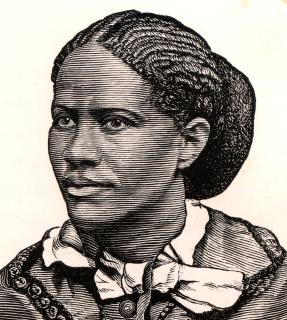Advertisement

Frances Ellen Watkins Harper (1825–1911), from an 1872 engraving. (Courtesy of the House Divided Project, Dickinson College)
Through what she called “threads of fact and fiction,” nineteenth- and twentieth-century author and activist Frances Ellen Watkins Harper challenged Unitarians and other Christians to practice a form of religion that reflected “a stronger sense of justice and a more Christlike humanity in behalf of those . . . homeless, ignorant, and poor.”
A black woman, she was born Frances Ellen Watkins to free parents in Baltimore in 1825. She held dual membership in Unitarian and African Methodist Episcopal churches in Philadelphia, and believed the struggles for black Americans and women of all races were connected. Her works were largely forgotten until scholars and Unitarian Universalists resurrected her legacy in the last twenty-five years.
Harper defied the racial and gender-based expectations of her day. In Standing Before Us: Unitarian Universalist Women and Social Reform, 1776-1936, the Rev. Dr. Qiyamah Rahman writes, “Harper’s education helped develop middle-class white audiences for her literary talents, [and] she was also able to write significant protest literature in the black liberation tradition.”
Much of her youth was devoted to abolishing slavery. In 1859, after abolitionist John Brown was sentenced to death for a failed attempt to seize an arsenal at Harpers Ferry, Virginia, she wrote letters to him and to his wife, Mary. The transcripts illuminate the liberatory theology that infused much of her work.
To John Brown, she wrote: “We may earnestly hope that . . . your martyr grave will be a sacred altar upon which men will record their vows of undying hatred to that system which tramples on man and bids defiance to God.”
In 1860 she married Fenton Harper, a widower with three children, and the couple had one daughter together. After her husband died in 1864, she returned to lecturing.
When the Civil War ended, Harper waged a dual campaign for women’s suffrage and civil rights for all citizens. In May 1866 she delivered an address to the National Woman’s Rights Convention in New York, saying before thousands, “Justice is not fulfilled so long as woman is unequal before the law. We are all bound up together in one great bundle of humanity, and society cannot trample on the weakest and feeblest of its members without receiving the curse in its own soul.”
Her words in New York laid out her theology and vision for a healthier society. For Harper, the stakes were high, and the “soul” of liberal religion—and the nation—was on the line. “You pressed [the Negro] down for two centuries,” she said, “and in so doing you crippled the moral strength and paralyzed the spiritual energies of . . . the country.”
Perhaps Harper’s most enduring work is her 1892 novel Iola Leroy, or, Shadows Uplifted. The book, which may have been the best-selling novel by an African-American before the twentieth century, explores the black title character’s decision to forego “passing” as white and work instead on fighting to end slavery and obtain civil rights for her people. Through Harper’s characters, Iola Leroy issues the call for religious persons to join struggles for freedom. In the novel, Iola asks her mother, “Are these people Christians who made these laws which are … reducing us to slavery? If this is Christianity I hate and despise it.” Iola’s mother responds, “I have not learned Christianity from them. I have learned it at the foot of the cross, and from [the New Testament].” The elder Leroy’s commentary is but one example of Harper’s denunciation of Christianity as commonly practiced in her day.
Harper’s multifaceted insistence on a liberatory religion evokes white Unitarian Lydia Maria Child’s 1833 “Appeal to End Slavery.” Child wrote of people who have grown used to slavery: “Christianity expressly teaches us to love our neighbor as ourselves. This shows how dangerous it is, for even the best of us, to become accustomed to what is wrong.”
Harper’s vision continues to resonate with scholars, feminists, and Unitarian Universalists. In 1992, several black Unitarian Universalists gathered in Collingdale, Pennsylvania, to honor Harper’s memory by replacing her headstone at Eden Cemetery, the oldest public black-owned cemetery in the United States. In 2011 scholars gathered in Philadelphia to honor the 100th anniversary of Harper’s death. Professor Melba Joyce Boyd, a panelist at the celebration, said, “Harper’s insight, developed during an era rife with violent enforcement of racism, sexism, and classism, constitutes a viable ideological framework for contemporary radical thought.”
Harper called on people of faith to resist the status quo and embrace a radical, liberatory Christianity. In the present climate of renewed calls for racial justice, Harper’s words still carry weight. She concluded Iola Leroy with a poem insistent on hope. In part it reads: “There is light beyond the darkness, joy beyond the present pain . . . the shadows bear a promise of a brighter coming day.”